Elderflower benefits are many and varied. The flower from the elder plant offers a plethora of health benefits, is delicious to flavor foods and drinks, and wonderful to use when making homemade products.
This post may contain affiliate links at no additional cost to you. By making your purchases through the links on this website, IMSL may make a small percentage at no direct cost to you. IMSL only promotes products we use & truly believe in. Please refer to my Privacy & Disclosures for further information. IMSL thanks you for your support!
Oh the magic of the Elder plant. The elderflower, not to be confused with the better known elderberries, are both from the same Elder plant, Sambucus genus.
The benefits of the elderflower and the elderberry are many. Both the berries and the flower of this amazing plant are utilized here on the hill every summer.
Most people are familiar with the elderberry, elderberry syrup anyone? & elderberry supplements, a common and readily available home remedy that’s available in most store’s today.
MAYBE OF INTEREST
Elderberry Tincture {How To Make And Use}
Lesser known is the elderflower. Beautiful, lacy white or yellow tiny flowers of the elder plant that pack a powerful punch all on their own.
Sharing Is Caring ❤️
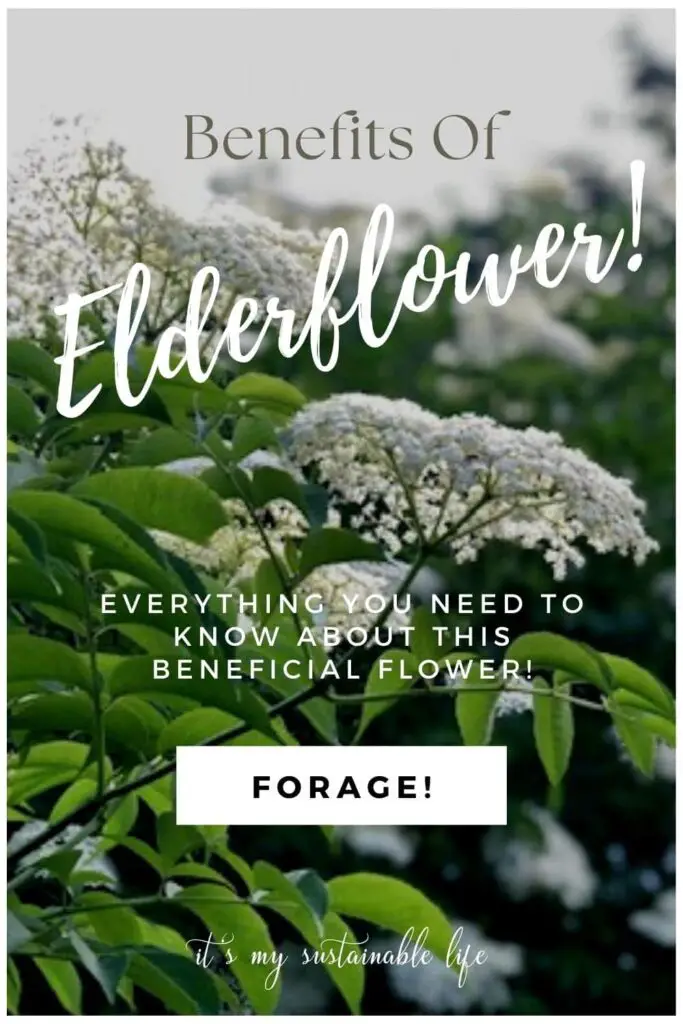
ELDERFLOWER DEFINED
Elderflower comes from the elderberry tree, Sambucus nigra ssp (here in the NE area), from the family Adoxaceae. Although technically a tree, the growth habit of this plant is more shrub-like here in our climate.
With an incredible growth rate of 6 to 12 feet within the first few years of the plant’s growth, the flower may take several or more years to appear. In some areas this tree can reach heights of 20 to 30 feet tall. Here on the hill, it remains more shrub-like, reaching only 6 to 8 feet tall or thereabouts.
Elder is easy to grow and requires little to no continued care. With a single plant offering many benefits throughout its growing season, this is one plant we couldn’t do without.
ELDERFLOWER IDENTIFICATION
The elderflower makes its appearance before the actual berry itself. Fortunately, identifying the elderflower is pretty simple.
For me here in the Northeast, elderflower is something that’s easily foraged. Great news for those who cannot grow it themselves!
As with any foraging endeavor, properly identifying the plant of choice is imperative. Elderberry, thank goodness, is one of the easiest plants to identify.
Although it may be tempting, elder that is growing near roadways is not the best choice to forage from. Exhaust fumes, road treatments and even runoff from pavement & concrete can pollute this healing plant.
When first learning to forage, I found it helpful to break the plant of interest down into its individual components.
ELDER LEAF IDENTIFICATION
The leaves of the elder plant are dark green in color. The top of the leaf tends to be a darker green than the paler underside.
They grow in 5-7 leaflets attached to each twig or stem with opposite pairs along the stem. Each leaflet possesses veins which can easily be seen, although they do fade off and narrow as they approach the leaf’s edge.
The individual leaflets grow longer in length than width, in an oblong shape, and feature “sawtooth”, serrated edges. On the underside of each leaflet you will find small “hairs” that grow readily.
The elder leaf is not edible.
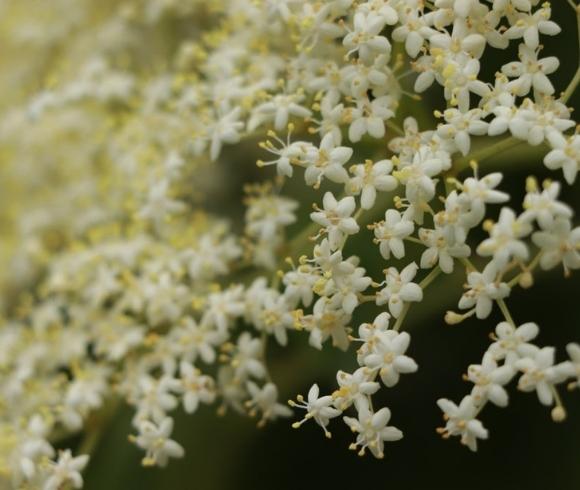
ELDERFLOWER FLOWER IDENTIFICATION
Elderflowers appear here in the NE right around mid-June. The flowers themselves grow in a cap-like or flattened formation that’s lacey in nature, creating a beautiful cluster of tiny white or cream colored flowers that tend to be star-shaped.
Interestingly, these flat flower caps can reach upwards of 10” in diameter and turn their blossomed heads toward the sun throughout the day!
The tiny elderflower possesses 5 delicate petals along with 5 thin tube-like filaments from the center of the flower. These filaments have a pale yellow tip. Typically you will see between 3-4 tips from each flower.
Elderflower is sweet smelling, although not potent. Did you know the scent of the flower comes from the pollen, not the flower petals themselves? Who knew?
They are a delicate flower, however, that packs a potent punch. They can be used either fresh or can be dried for later use.
ELDERBERRY BERRY IDENTIFICATION
From these delicate elderflower blooms comes the actual elderberry. This process will usually take about 6 to 8 weeks. Typically the berries will develop anywhere between late July and August here.
Initially green in color, the elderberries soon develop into deep, almost black, purple colored berries. The berry color can vary, however, some being dark blue or red.
They are ready to harvest once the cluster of berries begin to heavily hang on the stem in a downward fashion.
Elderberry should not be eaten raw and the taste is on the tart side.
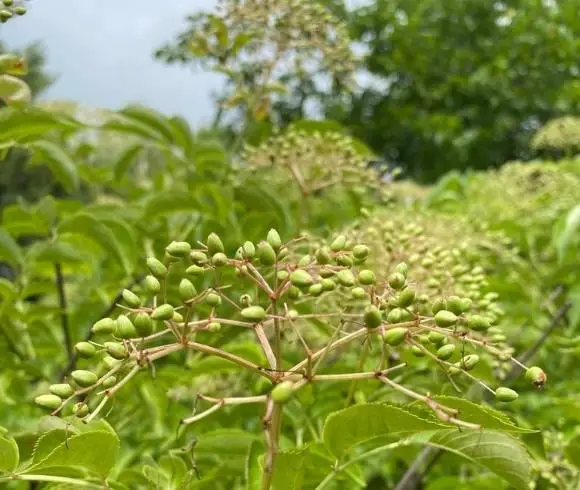
ELDER TREE BARK IDENTIFICATION
The elder tree has a very distinctive looking bark. Younger elder tree bark will have a lot of “warts” or lenticels. These younger tree’s branches tend to be on the brittle side and are filled with a creamy-white pith. The stems are hollow when cut.
The elder tree has a short trunk (bole) with grayish/brown bark that’s furrowed or corky looking when it matures.
The bark and stems of the elder tree are not edible.
ELDER TREE HABITAT
The elder plant enjoys its roots in rich, damp soil that’s neutral or moderately acidic. It enjoys lots of full sun and plenty of water.
You will easily find elder growing in boggy, wetland areas and alongside river & creek bankings.
Elder tends to be a hardy, deciduous plant, though, and can often be found off the beaten track along shorelines, open grounds, and even sprouting up in pavement gaps!
When foraging anything, follow sustainable guidelines by taking only what you need and ALWAYS leaving more than you take. Check with property owner’s if necessary and ask permission before foraging, and always be aware of any town, state, and federal laws that may apply.
DISCLAIMER
Recommendations and or suggestions made by this blog regarding husbandry and or herbal remedies etc. are not meant to replace solid advice from qualified professionals. None of the information on this blog has been evaluated by the FDA. Products or remedies mentioned are not intended to diagnose, treat, cure or prevent disease. Please do your due diligence. Research, talk to qualified professionals and proceed at your own risk.
HARVESTING ELDERFLOWER
Depending on your gardening zone and climate, elderflowers are typically ready for harvest come mid to late June here in the NE, but can range anywhere between May to June for most.
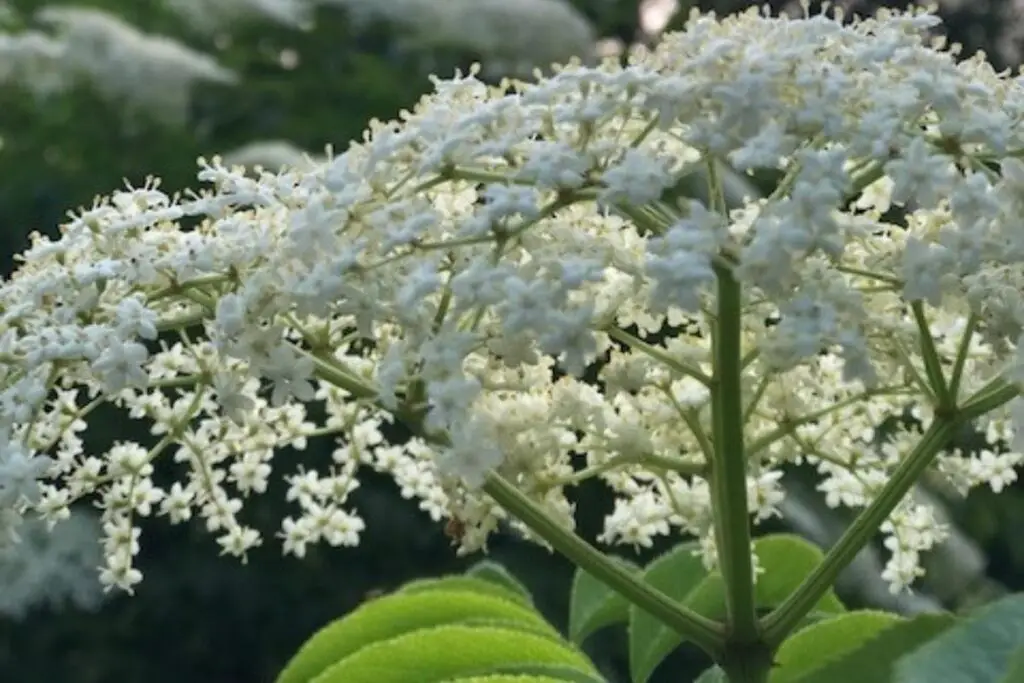
WHEN TO HARVEST ELDERFLOWERS
It should be noted that the time period for harvesting the elderflower tends to be a short one! Knowing when to harvest elderflowers is important as you don’t want to miss these short blooming flowers or mistakenly harvest any look-alikes that can be potentially harmful such as hogweed or hemlock and more!
As stated, elderflowers come into bloom in late spring to early summer. For us, again, that translates to mid-June.
You will know when it’s time to harvest the elderflower when the caps are fully in bloom or opened and are the freshest looking.
Avoid any clusters which have started their transformation, are dried out, or have faded to a brown or dark yellow color.
HOW TO HARVEST ELDERFLOWER
When harvesting the elderflower make sure you don’t have any hitchhikers. We are not the only ones who love our elderflower. Many insects do so as well. Taking a quick look at the flower cluster and giving it a gentle shake before cutting go a long way in dislodging most of the unwanted.
I recommend having a harvest bag, trug, or gathering basket on hand when harvesting.
The flower clusters are very delicate and can fade quickly and be damaged if placed into an airless container when fresh, losing much of their beneficial properties & flavors.
I recommend harvesting the flower clusters when dry, once the morning dew has evaporated, but while the ambient temps are still on the cooler side.

There are two methods for harvesting the flowers, and depending on what you will be using them for, you can decide which method is best.
When using the flower cluster for making elderflower fritters and such, you will want to snip off enough of the stem as will be needed for holding the flower cluster or umbel when dipping into the batter. It should be noted that the stem should NOT be eaten once cooked.
To harvest the flower only, you have a couple options.
- SHAKE METHOD – Once the flowers have fully opened, they fairly easily can be removed with a gentle shake over a large bowl or basket
- PULL METHOD – Alternatively, you can grasp the flower cluster and either massage the flowers from the head or grasp the cluster from the base and gently pull
Either way, the flowers should readily fall from their stems.
Once you have your flowers harvested, you can either use them fresh or preserve them by drying for future use.
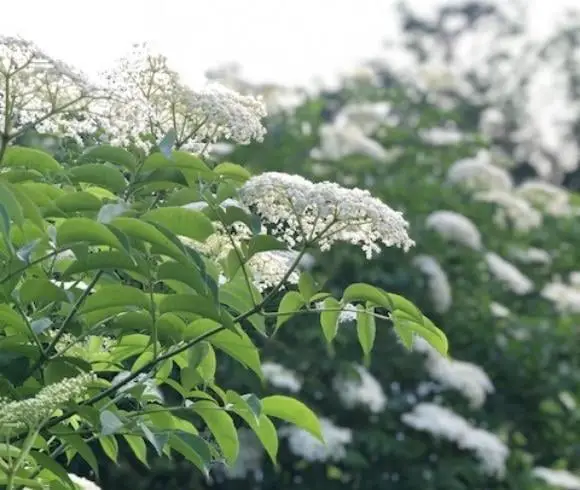
DRYING ELDERFLOWERS
To dry your flowers, lay them out onto a drying screen in a single layer and allow to air dry for several days or until completely dry. They will retain some of their creamy color, albeit a bit deeper tone once dried.
To store dried elderflower, simply place the dried buds into a bag or airtight jar and place it into a dark, cool location. My apothecary cabinet works as the perfect storage cabinet!
ELDERFLOWER SYRUP
Should you not want to dry your elderflower, consider making an elderflower syrup to add to beverages & cocktails, desserts, baked goods, and even ice cream!
To make elderflower syrup …
- Make a simple syrup, combining 5 C sugar, 4 C water, and 1 rounded tbsp citric acid to a large pot. Bring to a low boil to allow all the sugar to dissolve.
- Add 2 lemons sliced and 18 elderflower cluster flowers (fresh) to another large pot.
- Pour the simple syrup slowly over the lemons and elderflowers. Stir and combine well.
- Allow the mix to come to room temp, cover with an airtight lid. Should your lid not be airtight, cover with plastic wrap and then place the lid on top of that.
- Allow to stand at room temperature for 48 hours. A few times each day, give it a stir.
- Strain the mix through cheesecloth. You will be left with a clear, slightly yellow syrup.
- Add this strained syrup to another pot and bring to a boil. Turn the heat to a low boil and cook for 10 minutes.
- For long-term storage, pour your hot elderflower syrup into prepared canning jars and water bath process them for 10 minutes following the guidelines listed HERE.
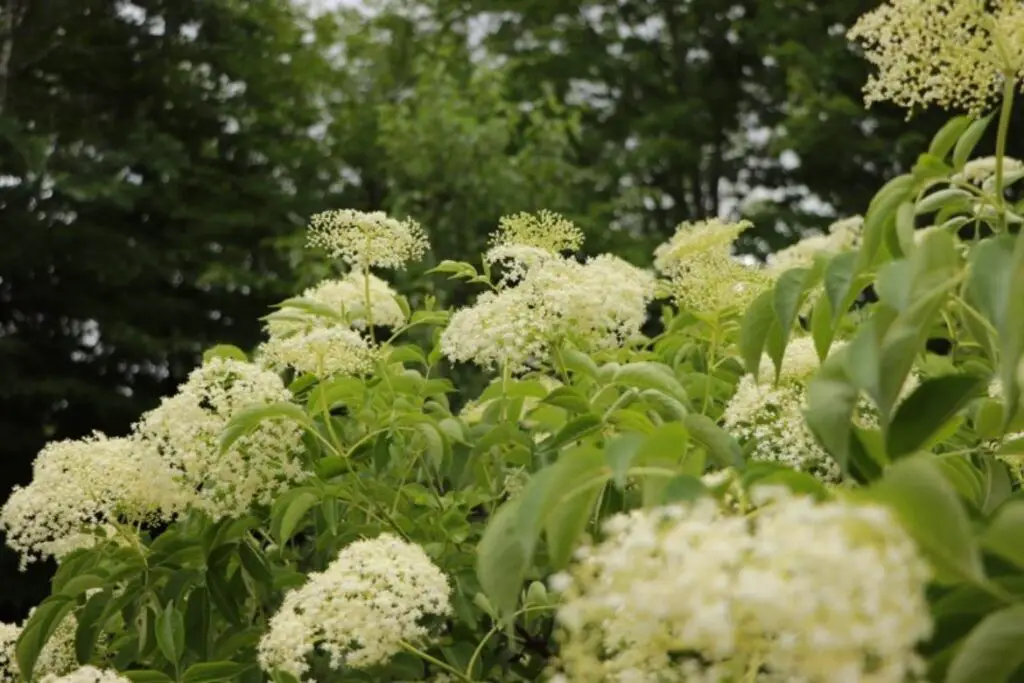
ELDERFLOWER BENEFITS
Even though the elderflower and the elderberry come from the same plant, they vary in their nutritional benefits, don’t possess the same compounds, and are used in very different ways.
The elderflower varies greatly from the berry in its flavor and aroma. The flower’s aroma boasts tones of passionfruit, citrus, and vanilla which are incredibly floral in scent.
The aroma & health benefits of elderflower tends to be indistinguishable & diminished once cooked, thus most elderflower applications do not involve using heat for lengthy periods of time.
Opposite of elderberry, the elderflower has no toxicities and can be eaten raw. Therefore you will likely see elderflower being used more in culinary applications than that of the berry.
Elderflower is often used when making teas, tonics, glycetracts, herbal extracts, cordials, and baking.
The elderflower, used in many medicinal preparations throughout the world, largely due to its antiseptic, anti-bacterial, anti-viral, and anti-inflammatory properties. It’s these properties which aid the healing of many health issues.
DISCLAIMER
Recommendations and or suggestions made by this blog regarding husbandry and or herbal remedies etc. are not meant to replace solid advice from qualified professionals. None of the information on this blog has been evaluated by the FDA. Products or remedies mentioned are not intended to diagnose, treat, cure or prevent disease. Please do your due diligence. Research, talk to qualified professionals and proceed at your own risk.
As always, before beginning any herbal preparation due your due diligence. Research, speak with your medical professional, and ask questions.
ELDERFLOWER FOR RELAXATION
The elderflower boasts nervine properties which aid the nervous system to calm during periods of high stress.
Especially delicious when taken as a tea, elderflower can also aid in bouts of depression. Add a few more herbs to the mix such as yarrow and peppermint and you have a wonderfully soothing concoction which aids with respiratory inflammation.
Speaking of respiratory issues ….
ELDERFLOWER FOR RESPIRATORY ISSUES
Elderflower benefits for respiratory issues, largely due to the tannins within which create an astringent action in the body, can aid in issues ranging from catarrh (mucus buildup), colds and seasonal flu, sinus infections, and other respiratory issues such as seasonal allergies.
Known to assist in building and maintaining a strong immune system, the elderflower supports respiratory health, working as a natural decongestant by helping clear mucus and congestion in lungs, sinuses, and nasal pathways.
Herbalists have long recommended taking elderflower as a daily aid in combating seasonal allergies to help ease symptoms.
ELDERFLOWER FOR JOINT ISSUES
Elderflower makes for a great addition to homemade salves and balms that aid with muscle pain and joint issues.
When making my dandelion balm for muscle aches (I add a bit of cayenne pepper and infused elderflower oil to the mix when needed here), swelling & pain is quickly reduced, and often completely eliminated.
The flower’s flavonoid properties, quercetin to be specific, is what assists the reduction of oxidative stress in the body. Thus, you will often find the addition of elderflower in many skin lotions. Those suffering from arthritis benefit very well by this addition.
ELDERFLOWER FOR DIGESTIVE ISSUES
Feeling a bit sluggish or constipated? Elderflower’s laxative properties aid in relieving those issues.
Anthocyanins, a group of 700+ plant compounds, aka, flavonoids, in the elder plant are a large factor in supporting gut health.
ELDERFLOWER FOR ORAL HEALTH
Used as an oral rinse or mouthwash, elderflower infusion is used for its antiseptic qualities, especially good for oral issues.
Gargle with the infusion to aid in helping out with laryngitis, coughs, and colds symptoms as well!
ELDERFLOWER FOR IRRITATED EYES
Need more ways to utilize elderflower infusions? Support tired, itchy, irritated eyes caused by too much screen time or seasonal allergies, by soaking a cotton ball or cosmetic pad in the infusion and lay them on the eyes.
Take it up a notch, cool your eyes even further by refrigerating the infusion and then making an eye compress to calm the eye’s even more quickly!
ELDERFLOWER ANTIBACTERIAL STUDY
With The World Health Organization (WHO) now recognizing antimicrobial resistance in medicine and agriculture as a major issue and one of public health importance, it’s no wonder that studies are now being conducted on herbal and natural options for assisting in many health issues.
MRSA, methicillin-resistant Staphylococcus aureus, a staph bacteria that’s become resistant to many antibiotics is typically found in hospitals and treatment centers. Research conducted in Ireland has shown elderflower’s antibacterial activity to positively combat many of these hospital pathogens.
ELDERFLOWER FOR SKIN HEALTH
Need help reducing skin irritations? Or maybe a little support in creating healthier skin overall is needed. Elderflower can help.
Used as a poultice on irritated skin or even as a cold infusion wash, elderflowers’ anti-inflammatory and antioxidant properties will promote a healthy glow.
ELDERFLOWER ACTIVE PROPERTIES
The elder plant, both the elderberry and the elderflower, are rich in nutrients (carbohydrates, proteins, fats, fatty acids, organic acids, minerals, vitamins (the flower is high in Vit C especially), and essential oils) according to this cited article.
In addition, elderflower boasts properties consisting of antioxidant activity (helps prevent or slow cell damage from free radicals), diaphoretic (excessive sweating), antipyretic (prevent or reduce fevers), and diuretic (promotes urination), and laxative agents.

These elderflower properties are exactly why they have been utilized throughout history in folk medicine.
In recent years, elderberry and elderflower have been found to have antibacterial, antiviral, antidepressant, as well as antitumor and hypoglycemic properties according to this article.
ELDERFLOWER PREPARATION OPTIONS
Elderflower is incredibly versatile and easy to use in homemade preparations. Here are a few in no particular order to consider.
ELDERFLOWER TEA
Make a simple tea by boiling hot water over fresh or dried elderflower. Add a few other herbs along with if you choose to create a soothing, delicious brew.
ELDERFLOWER INFUSION
Need a bit more strength than just tea? Consider making an herbal infusion. One that steeps overnight or for long periods of time.
What is an herbal infusion and how is it different than tea?
“Herbal infusions {uses large amount of leaves, stems, & flowers}, commonly referred to as decoctions {typically uses roots, bark, & seeds}, are one of our most revered methods to use herbs as a restorative {bringing the body back into balance} as well as for medicinal purposes.”
IMSL
Use the infusion for mouthwash, gargling, eye compress, and so much more!
And don’t just stop at infusing water! Consider infusing honey, vinegars (think ACV, white wine vinegar and even champagne vinegar here), and your favorite oil for use in homemade lotions! The possibilities are only limited to your imagination!
ELDERFLOWER CORDIAL OR SYRUP
Elderflower cordial or syrup, a sweet drink that’s amazingly fragrant and concentrated, can be added to your favorite drinks, seltzer, cocktails, and even into baked recipes and desserts.
The flavors of the elderflower go especially well with tart fruits such as rhubarb. You can be sure I will be adding this infused sweetener to my rhubarb juice this spring!
Need even more uses? The syrup makes for a flavorful drizzle over my homemade ice cream or my homemade yogurt! So many unique ways to use elderflower cordial or syrup in the kitchen!
ELDERFLOWER TINCTURE
Tinctures are one of the favorite herbal preparations we make here on the hill. Why? They are easy to make, shelf stable for an indefinite period of time, and efficacious to use.
Many of you have probably already heard about elderberry tincture. Were you aware that you can also make an effective tincture from elderflower?
To make your own in a nutshell, place dried elderflowers that have been slightly crushed into a jar and cover with 80 proof or higher vodka (imparts no flavor), cover and place into a dark cool cabinet for 4-6 weeks. Make sure to give the jar a shake every now and then to incorporate everything well. Strain and store the tinctured liquid in a dark amber colored glass in a dark, cool cupboard.
This is by no means an exhaustive list of the ways you can utilize and capture all the elderflower benefits!
But it’s a start 😊 Hopefully you will be foraging and collecting elderflower this spring and putting it to good use in your own home apothecary and kitchen cupboards.
How will you be putting the elderflower benefits to use?
Love, Light, & Laughter ~

SHOP THIS POST
Enjoy this article? Please consider sharing it on your favorite social media channel! Want more? Subscribe below for the occasional update with all the “happenings on the hill”!

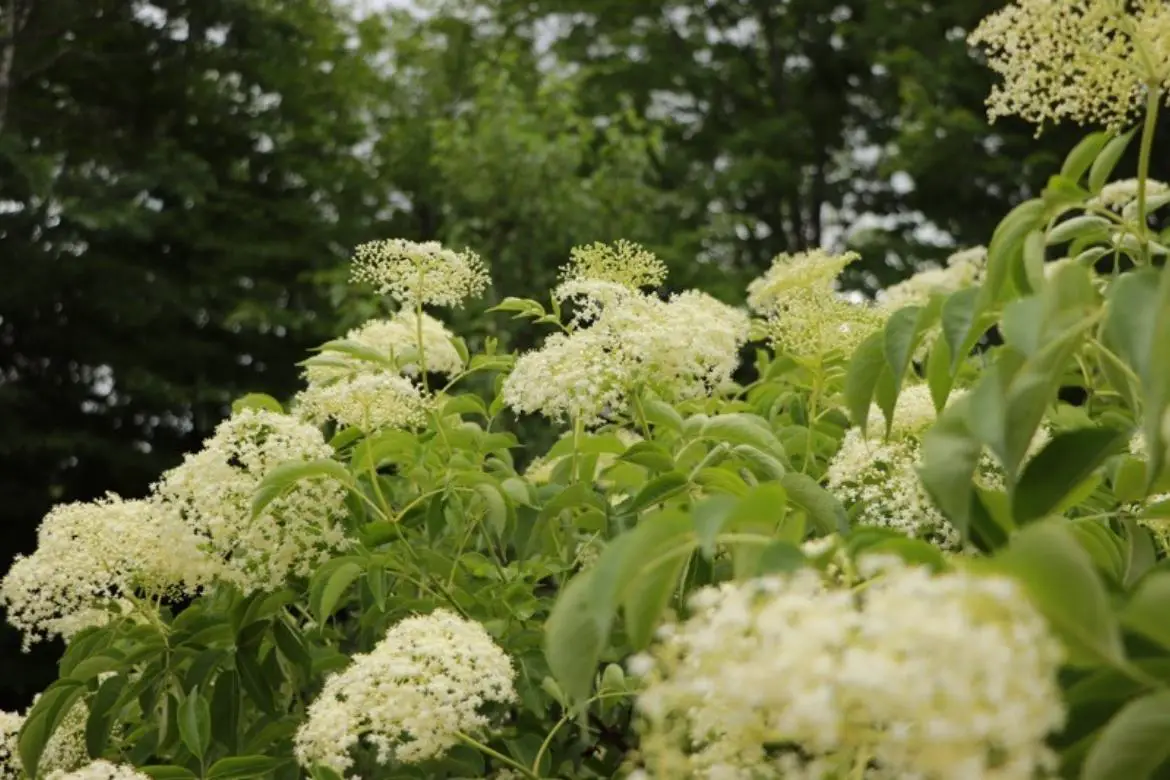

5 comments
Elderflower has so many benefits! We have definitely stocked up on Elderberry this season but I never knew much about the plant. I love doing anything in a natural way!
Wow, the elderflower is so pretty and it has so many beneficial uses! I had no idea. The tea sounds lovely, and I would be curious as to how elderflower would affect my skin. I may have to try a product with elderflower and see what happens!
I wasn’t aware of all the benefits of the elderflower. And thanks for the recipe to make elderberry syrup.
Your welcome!
Hi Suzan, I love reading about elder flower and how to use them. Great site overall. Informative and useful! I just started a blog about being food self sufficient.